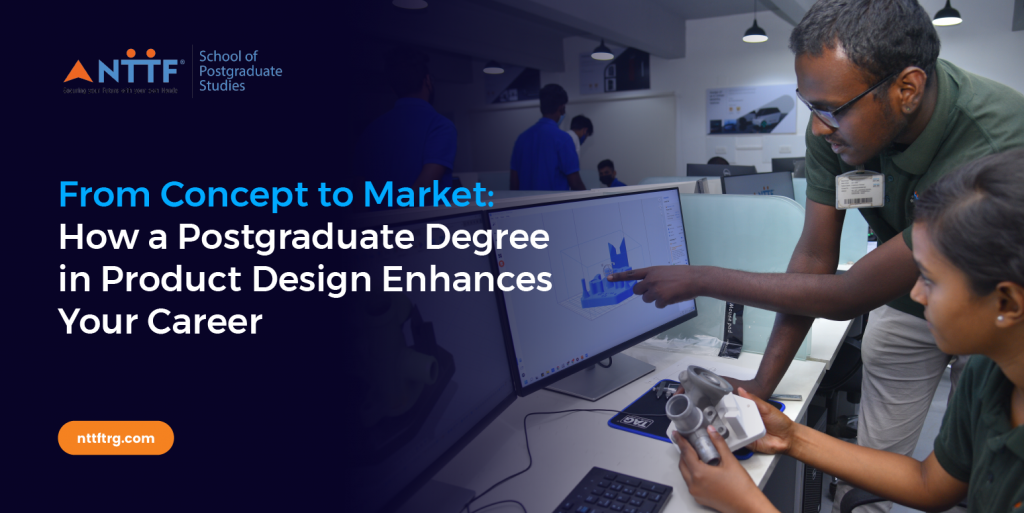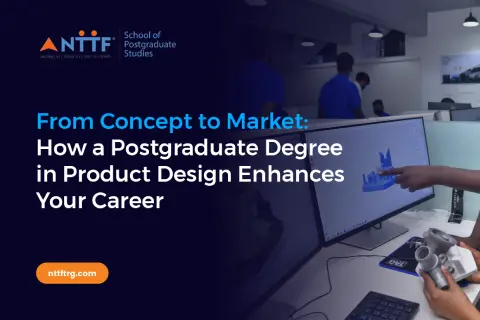From Concept to Market: How a Postgraduate Degree in Product Design Enhances Your Career
December 23, 2024 2024-12-24 11:08From Concept to Market: How a Postgraduate Degree in Product Design Enhances Your Career

In the world of innovation and competitive industries, product design is the key to bridging creative ideas with engineering excellence. Whether it’s the sleek design of a smartphone or the functional elegance of a medical device, every product begins as a concept that must be meticulously designed and engineered to thrive in the marketplace.
Achieving expertise in this ever-evolving field requires more than just foundational knowledge. It demands specialized skills, industry insight, and the ability to adapt to cutting-edge technologies. A Postgraduate Degree in Product Design & Engineering empowers you with all these capabilities, enabling you to take ideas from concept to market efficiently and effectively.
At NTTF, the Postgraduate Programme in Product Design (PGPDE – CP 07) is tailored to equip B.E. And B.Tech graduates with the skills and knowledge they need to excel in product design and engineering. This blog explores how this program can transform your career and prepare you for leadership roles in this dynamic industry.
Why Product Design Is a Game-Changer
Product design is the backbone of innovation, enabling businesses to create products that are functional, appealing, and market-ready. It combines creativity, engineering precision, and strategic thinking to craft solutions that address user needs while meeting business goals. Here’s why product design is a vital and rewarding career path:
1. Wide Industry Applications
Product design skills are relevant across industries like automotive, healthcare, electronics, and consumer goods, offering diverse career opportunities.
2. Integration of Advanced Technologies
Technologies such as AI, 3D printing, and virtual prototyping are reshaping product design, increasing the demand for skilled professionals.
3. Focus on Sustainability
As industries prioritize eco-friendly practices, product designers are instrumental in developing sustainable solutions and reducing environmental impact.
4. Global Career Opportunities
Companies worldwide are seeking innovative product designers to create competitive and market-leading solutions, ensuring a wealth of global career prospects.
Why Pursue a Postgraduate Degree in Product Design & Engineering?
A PG Degree in Product Design & Engineering elevates your skillset and prepares you for high-level roles in the industry. It goes beyond foundational knowledge, allowing you to master advanced tools, techniques, and methodologies. Here’s how:
1. Master Cutting-Edge Skills
Gain expertise in advanced areas such as rapid prototyping, design validation, and sustainability. Master tools like CAD, CAE, and PLM software to create innovative and market-ready products.
2. Stay Ahead with Emerging Technologies
Learn how to leverage Industry 4.0 technologies, including IoT, robotics, and AI, to design products that are smart, efficient, and future-proof.
3. Hands-On Industry Exposure
Through projects, internships, and industry collaborations, postgraduate programs offer experiential learning opportunities that prepare you for real-world challenges.
4. Become a Leader
Develop leadership and project management skills, enabling you to lead teams, manage complex projects, and contribute to strategic decision-making.
5. High Earning Potential
Advanced qualifications and specialized skills often lead to better job roles, faster career growth, and higher salaries.
NTTF’s Postgraduate Degree in Product Design & Engineering (PGPDE- CP 07): Your Path to Success
NTTF’s Postgraduate Programme in Product Design & Engineering (PGPDE – CP 07) is an industry-focused program designed to transform you into a highly skilled professional. With a blend of theory and practical training, this program ensures you gain the expertise needed to excel in the competitive world of product design.
Program Features:
- Comprehensive Curriculum: Covers everything from design thinking to advanced manufacturing technologies.
- Modern Facilities: Access state-of-the-art labs equipped with the latest tools and technologies.
- Experienced Faculty: Learn from seasoned professionals who bring their industry expertise to the classroom.
- Industry Partnerships: Collaborate with leading companies on projects, internships, and potential job placements.
- Career Support: Benefit from strong placement assistance and industry connections.
What You Will Learn
The Postgraduate Diploma in Product Design (PGPDE – CP 07) at NTTFis a 2 year program divided into 4 semesters that focuses on equipping students with technical proficiency, creative problem-solving abilities, and practical knowledge.
Core Areas of Study:
- Design Thinking and Innovation
Explore human-centered design approaches that prioritize user needs and foster innovative solutions. - Advanced CAD & CAE
Develop expertise in computer-aided design and engineering tools like SolidWorks, CATIA, and Ansys to create precise and optimized product designs. - Prototyping Techniques
Learn rapid prototyping methods such as 3D printing and CNC machining, enabling you to create functional prototypes quickly and cost-effectively. - Sustainability in Design
Focus on eco-friendly practices, material selection, and lifecycle analysis to design sustainable products. - Manufacturing Processes
Understand diverse manufacturing techniques, including injection molding, additive manufacturing, and assembly processes, to ensure design feasibility. - Validation and Testing
Gain proficiency in testing methods to validate product performance, ensuring reliability and quality. - Industry 4.0 and Smart Technologies
Leverage IoT, AI, and data analytics to design smart, connected products for the modern market.
Career Opportunities After Postgraduate Degree in Product Design & Engineering
A Postgraduate Programme in Product Design prepares you for a variety of roles that require both technical expertise and creative thinking. Here’s a look at potential career paths:
1. Product Designer:
This is the most direct and versatile path for graduates. As a product designer, you’ll be involved in the entire design process, from ideation to manufacturing. You’ll:
- Conduct user research: Understand user needs and preferences through interviews, surveys, and usability testing.
- Develop concepts and prototypes: Translate user insights into tangible product ideas and create prototypes to test and refine your designs.
- Collaborate with engineers and manufacturers: Ensure your designs are feasible to produce and meet technical specifications.
- Create detailed 3D models and technical drawings: Use CAD software to create precise representations of your designs for manufacturing.
- Stay updated on industry trends and emerging technologies: Continuously learn and adapt to the ever-changing landscape of product design.
Industries: Consumer goods, electronics, furniture, medical devices, toys, sporting goods, automotive, and more.
2. UX/UI Designer:
With the rise of digital products and applications, UX/UI designers are in high demand. You’ll focus on creating user-centered designs for websites, mobile apps, and software interfaces. You’ll:
- Conduct user research: Understand user behaviors, needs, and pain points.
- Design user flows and wireframes: Create blueprints for the user experience and information architecture.
- Design interactive prototypes: Develop interactive prototypes to test and refine the user interface.
- Collaborate with developers: Ensure your designs are implemented effectively and meet technical requirements.
- Stay abreast of UX/UI best practices and emerging trends: Continuously learn and adapt to the evolving digital landscape.
Industries: Technology companies, e-commerce, digital agencies, startups, finance, healthcare, education, and more.
3. Industrial Designer:
Industrial designers focus on the form and function of mass-produced products. You’ll:
- Develop concepts for products with mass appeal: Consider aesthetics, ergonomics, functionality, and manufacturing costs.
- Create detailed 3D models and renderings: Visualize your designs using CAD software and rendering tools.
- Collaborate with engineers and manufacturers: Ensure your designs are manufacturable and meet quality standards.
- Stay updated on manufacturing processes and materials: Continuously learn about new materials and production techniques to optimize your designs.
Industries: Manufacturing, consumer goods, automotive, aerospace, furniture, appliances, and more.
4. Design Engineer:
As a design engineer, you’ll bridge the gap between design and engineering. You’ll:
- Apply engineering principles to product design: Ensure your designs are structurally sound, functional, and meet performance requirements.
- Use CAD/CAM software to create detailed models and simulations: Analyze and optimize your designs for manufacturability and performance.
- Collaborate with designers and manufacturers: Integrate design aesthetics with engineering constraints.
- Stay updated on engineering advancements and manufacturing technologies: Continuously learn and adapt to the evolving technological landscape.
Industries: Manufacturing, automotive, aerospace, robotics, medical devices, consumer electronics, and more.
5. Creative Director:
With experience and leadership skills, you can aspire to become a creative director. You’ll:
- Lead and manage design teams: Guide and mentor designers, fostering a collaborative and creative environment.
- Develop design strategies and vision: Align design with business objectives and brand identity.
- Oversee the entire design process: From concept to launch, ensuring quality and consistency across all design projects.
- Stay ahead of design trends and market demands: Continuously research and analyze the evolving design landscape.
Industries: Design agencies, advertising, marketing, branding, technology companies, and more.
6. Design Researcher:
If you have a strong interest in user research and data analysis, you can pursue a career as a design researcher. You’ll:
- Conduct user interviews, surveys, and usability testing: Gather qualitative and quantitative data to understand user needs and behaviors.
- Analyze data and identify key insights: Translate research findings into actionable recommendations for design teams.
- Communicate research findings effectively: Present your insights through reports, presentations, and visualizations.
- Stay updated on research methodologies and user-centered design principles: Continuously learn and refine your research skills.
Industries: UX design, product development, market research, academia, and more.
7. Entrepreneur:
A postgraduate degree in product design can also equip you with the skills and confidence to start your own business. You can:
- Launch your own design consultancy: Offer your design expertise to clients across various industries.
- Develop and market your own product ideas: Bring your innovative concepts to life and build a successful product-based business.
- Leverage your design skills in other entrepreneurial ventures: Apply your design thinking and problem-solving abilities to various business challenges.
Beyond Traditional Roles:
The skills and knowledge gained from a postgraduate degree in product design are highly transferable and can open doors to various non-traditional roles, such as:
- Design Educator: Share your passion for design by teaching at universities or design schools.
- Design Writer or Journalist: Contribute to design publications, write reviews, or cover design events.
- Design Consultant for Nonprofits: Use your design skills to address social issues and contribute to positive change.
The key takeaway: A postgraduate degree in product design provides a solid foundation and a competitive edge for a fulfilling and successful career in a wide range of industries and roles.
Why Choose NTTF?
NTTF (Nettur Technical Training Foundation) is synonymous with excellence in technical education. Here’s what makes NTTF the perfect choice for pursuing a PG Diploma in Product Design:
1. Industry-Integrated Curriculum
Developed in collaboration with industry leaders, ensuring relevance and employability.
2. Experiential Learning
Emphasis on practical training through labs, workshops, and real-world projects.
3. Placement Support
NTTF’s strong industry connections and placement assistance guarantee excellent job opportunities.
4. Expert Faculty
Learn from professionals with extensive academic and industry experience.
Admission Details
Eligibility:
- Bachelor’s degree in engineering or related fields.
Program Duration:
- Two years (full-time).
How to Apply:
- Visit the NTTF website to complete the application process.
Realizing Your Potential: A Postgraduate Degree That Transforms Careers
A Postgraduate Degree in Product Design & Engineering is not just about gaining advanced knowledge—it’s about becoming a thought leader and innovator in your field. With NTTF’s PGPDE, you will gain the skills, experience, and industry connections needed to create products that impact lives and define the future.
The journey from concept to market is both challenging and rewarding. By enrolling in NTTF’s Postgraduate Degree in Product Design & Engineering, you’ll equip yourself with the tools and expertise to navigate this journey successfully. Whether you aspire to innovate in healthcare, redefine consumer technology, or champion sustainable solutions, this program will pave the way for a fulfilling and impactful career.
Don’t wait—take the first step toward your dream career today!








